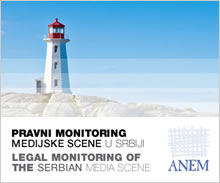20. 11. 2012
The media careless about children rights
Belgrade, November 20, 2012 (UNICEF Serbia) - As a rule, leading news articles about violence against children violate the Journalists' Code of Ethics, state Association of Journalists of Serbia and UNICEF Serbia
Electronic media are more ethical in reporting on violence against and among children than print media. Although most press articles do respect the Journalists' Code of Ethics and the rights of the child, the most conspicuous ones, published on the front page, regularly violate the Code.
The findings of the media monitoring carried out by UNICEF and the Association of Journalists of Serbia (UNS) from 15 July to 20 September 2012 show that nearly one third of articles about the most brutal abuses are mainly published on front pages, indicating sensationalistic intentions.
Monitoring of the media coverage of violence against and among children covered articles published in the Serbian daily newspapers Politika, Danas, Blic, Pres, Večernje novosti, Kurir and Alo, as well as reports on the electronic media - Radio Television Serbia (RTS), B92, Prva TV and Studio B.
Underneath an illusion of thematic diversity, Serbian media are still predominantly marked by the "parental" attitude which faithfully accompanies the deep-rooted rules of power in a conservative patriarchal society - children are mainly objects of protection by adults; stories about them are most frequent when they are not safe and protected, or on the occasions when society "turns the spotlight" on them, such as at the beginning of a new school year (policemen in schools, security cameras, etc.).
When it comes to violence, the most-reported incidents occur in the family and in school, two traditionally child-friendly environments. Violence against and among children has only recently become a more openly-discussed subject, and the standards for press reporting on it are still being established.
During the survey period (15 July-20 September), electronic media did not include any noteworthy report on violence against and among children, while print media published a total of 527 articles about children, of which one third related to violence against and among children. Of this latter total of 162 articles, 37 per cent were about domestic violence, and 5 per cent concerned peer violence. Ethical standards were respected in about two thirds of these articles, but in a little under a third, the Journalists' Code of Ethics, the rights of the child and the best interests of the child were violated. In almost 30 per cent of cases, the complete identity of children was revealed. Unnecessary ethnic identification was noted in more than 15 per cent of cases. It is interesting that 40 per cent of articles were accompanied by photos which most often violated the Code and the rights of the child. As many as 87 per cent of the published photographs clearly show the house in which the abused child lives, his or her guardians, or reveal a settlement, thus making the overall location identifiable.
Experts talk instead of children
As regards daily coverage in the electronic media (i.e. excluding specialized programmes for children), the situation is slightly better than in the print media. When choosing a theme, it is evident that the priority is to follow agency news, which means that journalists rarely impose their own research topics. It is in fact very much the other way around - they try to keep up with daily events (mainly accidents) and specific events, such as the beginning and end of the school year, testing of children for enrolment or routine testing of knowledge, World Breast-feeding Week, the fight against hunger, free HIV tests and the like.
As with print media, electronic media rarely deal with the problems of children and adolescents, except when they concern young persons with disabilities, or those seriously ill in need of financial assistance for medical treatment, or when they come from poor families who live on social welfare payments or receive no such payments at all.
There are frequent reports on education, but they rarely reveal what children think about the quality of teaching, textbooks or teachers themselves. Children are also hardly ever asked for their opinion in reports concerned with learning difficulties (of which there are, at any rate, only a very small number)), growing up, their ambitions and aspirations. Instead of children, those things are talked about by experts - researchers, pedagogues, psychologists, sociologists and so on.
Journalists are obviously not accustomed to collaborate with children. That is why the voices of children are rarely heard in the media, and then mainly as illustrations of the success or failure of adults.
When choosing interlocutors, journalists generally opt for exceptionally gifted children in science or sport, which reduces coverage to their success, work and "sacrifice". These children certainly deserve that attention. However, so-called "ordinary" children, or those whose talents remain unknown, rarely get such a chance. It is an unwritten rule, particularly when they are not the victims of violence, that children appear in a report or a newspaper article only if there is some time left in broadcasters' programme schedules, or when and if there is some space left in print media.
Superficial media coverage intensifies misconceptions and prejudices
On the basis of two-months' monitoring, it can be concluded that media mirror the power structure of society, which means that marginalized persons will continue to get less media attention, particularly where children are concerned. Nevertheless, media play a critical role in reporting on the rights of the child, regarding respect for or violation of those rights. By revealing and drawing attention to cases of violence, media should examine ways it could be stopped and, through competent collocutors, propose solutions that perhaps might be heard and adopted by decision-makers. However, it is easier to create a sensation than investigate real causes. A superficial story may attract an audience and capture its attention, but such work can only intensify misconceptions and prejudices.
-
No comments on this topic.





